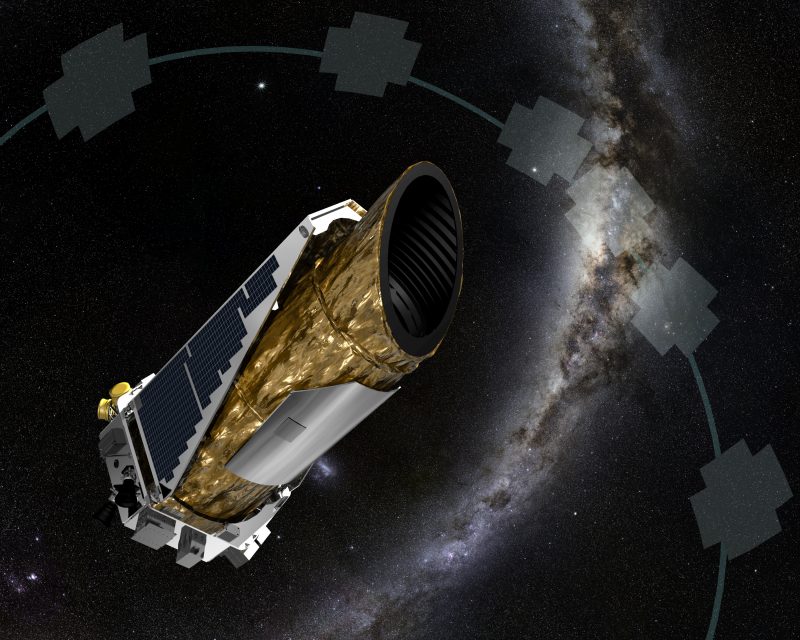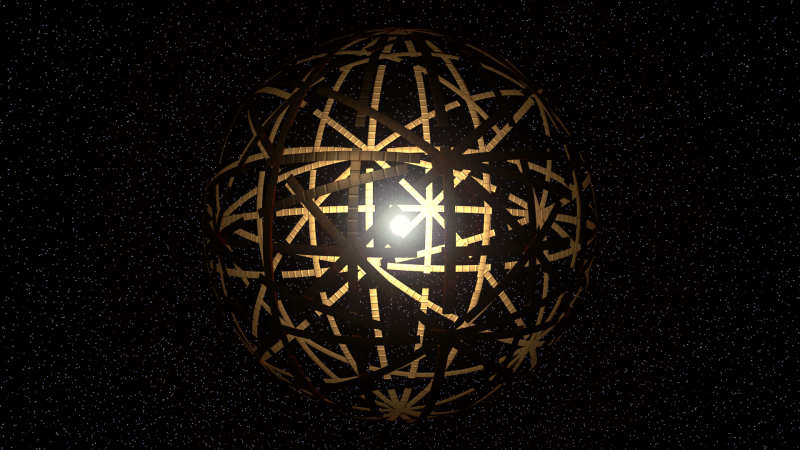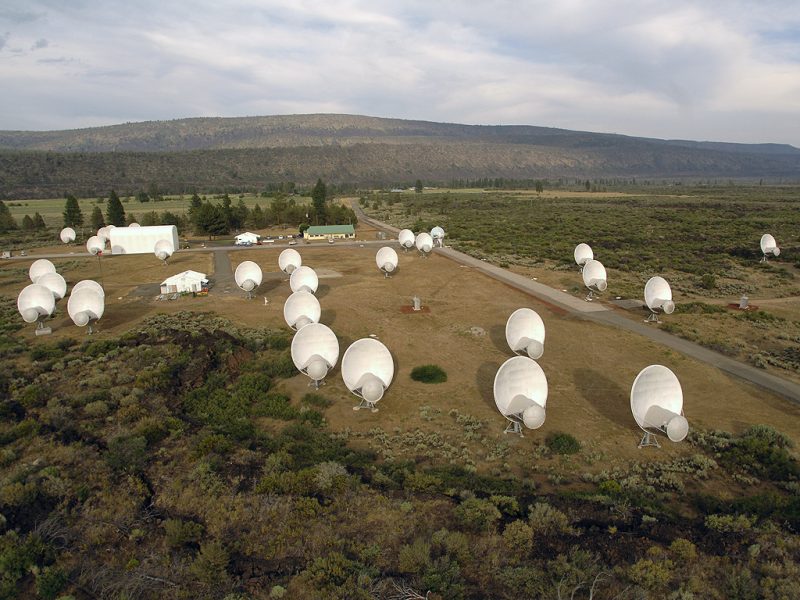Scientists at the SETI (Search for Extra-Terrestrial Intelligence) Institute have started using the Allen Telescope Array (ATA) to hunt for signals from a star called KIC 8462852, located in the constellation Cygnus at approximately 1,481 light years from the Earth. Recently, KIC 8462852 has become the “most mysterious star in our galaxy”.
Could this distant star be the home of an alien civilization capable of building huge solar energy collectors, or is this just another space phenomenon that we still haven’t explained? In any case, this is a perfect job for SETI.
More than two weeks ago Planet Hunters, a citizen science program that was launched at Yale university in 2010, reported that the brightness of the star KIC 846 3852 is changing in time with variations of up to 20%. This variation is much bigger than something that could be explained by a planet-like object passing in front of the star. The intervals in which the brightness drops are ranging from 5 to 80 days.
Planet Hunters used data from NASA’s Kepler planet-hunting probe. The probe is designed to survey a portion of our region of the Milky Way galaxy to discover dozens of Earth-size planets in or near the habitable zone. After a group of “citizen astronomers” reported the same finding, the data was sent to the group’s advisory science team, which includes Yale postdoctoral astronomy fellow Tabetha Boyajian.

“It did definitely spark some lively discussions on the talk boards. We scrolled through the discussion boards and superusers, and they let us know that there’s something we should be watching out for,” Boyajian says.
At the moment, there are two research papers offering two different explanations of the KIC 846 3852 brightness variation. The first one is by Tabetha Boyajian and her colleagues. They explain that irregular streams of comets or comet fragments are periodically blocking the starlight from KIC 8462852. This maybe sounds like a bizarre coincidence, but it is the best natural phenomenon explanation so far.
The other research, made by Tabetha’s colleague, Penn State astronomer Jason Wright, sounds like something out of a Sci-fi movie. He suggests that extraterrestrial space race might have built a collection of large structures in orbit around KIC 8462852 – the purpose of those structures would probably be energy harvesting. It is not the first time that people spoke about that kind of systems.

They are known as Dyson spheres. They were first described by Olaf Stapledon in his science fiction novel, Star Maker (1937), and later popularized by Freeman Dyson in his 1960 paper, “Search for Artificial Stellar Sources of Infrared Radiation”. They are considered as potential energy sources for advanced civilizations.
Jason Wright is cautious with his theory by saying: “My philosophy of SETI (referring to the search for extraterrestrial intelligence) is that you should reserve your alien hypothesis as a last resort.”

As of 15th October, SETI astronomer Doug Vakoch and his team at the SETI institute pointed the dishes of the Allen Telescope Array (ATA) towards KIC 8462852 and they are carefully monitoring and listening for unusual signals. Ater the news broke out, Doug and his colleagues are the first people to explore the star for potential alien presence.
He stated: “We’re trying to rule out the hypothesis that maybe it’s intelligence out there… Our assumption is that there’s going to be a natural explanation for this, we just haven’t gotten clever enough to find it.”
The ATA is a radio telescope that can tune into 9 billion different frequencies between 1 and 10 GigaHertz. It was Initially developed as a joint effort between the SETI Institute and the Radio Astronomy Laboratory (RAL) at the University of California, Berkeley, with more than $30 million funding from billionaire Microsoft co-founder Paul Allen. The array of 42 dishes is located near the remote town of Hat Creek. Hat Creek was chosen for the telescope because of the low radio interference from human civilization.

Vakoch explains the difficult task of trying to find a genuine signal coming from another star:
“We’re looking for a signal at one spot on the radio dial, and the problem is we don’t know which spot. And so we tune the dial to billions of different channels. It’s almost like we’re searching the cosmic cable TV but instead of trying to find intelligence on 400 or 500 channels, we’re looking at billions of channels.”
To make things more complicated, the satellites in earth’s orbit and the radio transmitters on Earth are sending signals that work on the same frequencies that ATA uses. That is why the SETI scientists are tuning the array to three different stars at the same time, this way they are sure they are picking up the right, alien, signals and not a random Earth transmission.
“What we want to find is a signal coming from one of those stars and not from the other two. What we typically find is that if there’s a satellite flying over it’s in our telescope and it’s going to look like we’re getting that signal at all three of those stars, and then we know it’s a false alarm.”
Vakoch told the press that after the observations are finished (23 of october was the expected date), they’ll immediately begin writing up their results, but even if something unknown is discovered, the information won’t be presented for at least few weeks.
The SETI scientist is optimistic about the final results, no matter what they find out:
“If we find what we’re looking for it will tell us one of two things: Either we have found an extraterrestrial that is sending us a signal that’s very similar to our own radio technology, or we have discovered a radically new natural phenomenon that makes this star system even freakier than it is right now.” Dr. Seth Shostak, a senior astronomer at the SETI institute, made a statement regarding the enigma of KIC 8462852. You can find the full statement on the SETI website.
“The SETI Institute is following up on the possibility that the stellar system KIC 8462852 might be home to an advanced civilization.”
He continues:
“For various reasons, it’s obvious that this material is not simply a planet. A favored suggestion is that it is debris from comets that have been drawn into relatively close orbit to the star.
But another, and obviously intriguing, possibility is that this star is home to a technologically sophisticated society that has constructed a phalanx of orbiting solar panels (a so-called Dyson swarm) that block light from the star.” “On the basis of historical precedent, it’s most likely that the the dimming of KIC 8462852 is due to natural causes. But in the search for extraterrestrial intelligence, any suggestive clues should, of course, be further investigated – and that is what the SETI Institute is now doing.”
Besides SETI, there are also many other teams of scientists observing the star for the past two weeks. People around the world are eagerly expecting to see what is going to be discovered. The results will be exciting, no matter what. Let’s wait and find out.
Source: businessinsider, geekwire, talk-technology, atropix, theatlantic, nasa
